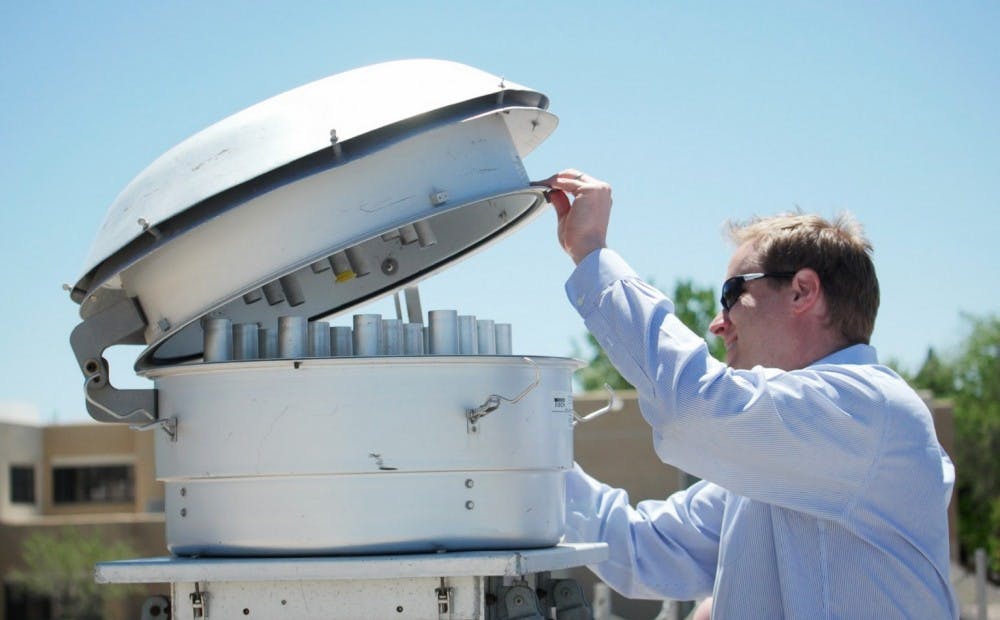As early as Thursday, UNM researchers will take a mobile laboratory to the Blue Gap-Tachee Chapter of the Navajo Nation to study uranium mine dust and its health effects on the local residents.
After a four-hour drive, researchers will work for three months at Blue Gap-Tachee in a three-room semi-trailer equipped with a particle concentrator that serves as a mobile lab. UNM is collaborating with Michigan State University, who provided the lab, as well as the Southwest Research and Information Center on the project.
Lead project researcher Matthew Campen said research is already being done at UNM about mine waste-related health concerns around topics like seepage into groundwater. However, little work has been done on the effects of inhaling dust from the mine.
In preliminary research, shows that mine dust contains uranium and vanadium, which can be toxic in lungs, Campen said. Half a year into its five-year grant, the study focuses on the effects of inhaling these particles.
Carnotite, the mineral that contains uranium and vanadium, should be a large rock, but the dust contains nano-sized particles which amplify health issues, he said.
Campen believes the weathering of the past three decades has created these smaller particles, which has a major effect on particle toxicity.
“The size of the particles is very important,” Campen said. “If they’re larger than ten microns, you won’t even breathe them at all. If they’re smaller than one micron, they may even get into the alveoli, the very deep part of the lung. So now we’re talking about a 10th or 20th of a micron is the size of the particles, so they can get very deep.”
The particles also have a larger surface area, creating more bad reactions in lungs, he said.
The Blue Gap-Tachee Chapter is also in support of the work, Director of the Uranium Impact Assessment Program at SRIC Chris Shuey said.
They have issued multiple resolutions, including one as early as 1988, in support of researching health effects of the uranium mine, he said. In September, the chapter passed a resolution in support of the work UNM is doing specifically.
“They said, we want this research to be done not as much for the older generations but for the generations to come, and ultimately, we want these sites cleaned up. We don’t want this in our community anymore. This is a black page from bad history,” Shuey said.
Homes and livestock are located within 100 yards of the uranium mine, Campen said.
Get content from The Daily Lobo delivered to your inbox
Some perfunctory reclamation of the mine site was done in 1991 and 1992, and in 2011 the EPA attempted to clean up the site, Shuey said.
This cleanup involved shoving mine waste over the edge of the mesa, Campen said.
“When we actually go out there and stand on top of that pile, the radiation is six, seven, background,” he said. “It’s not clean, is the bottom line. But is it clean enough? Is it really causing a public health hazard? That’s the question we’re trying to address.”
SRIC bridges the gap between the academics at UNM and the community itself and has worked on uranium problems in the Navajo Nation for many years, Shuey said.
“We’re outsiders to these communities. We have to behave in ways that are respectful to the communities. We don’t tell the communities what they should care about. We respect the agenda of the community,” he said, adding that the community’s knowledge of the area has been crucial to moving forward with this research.
The site they are studying is only one of five hundred mine sites in the Navajo Nation, and many haven’t been remediated completely, Campen said, emphasizing that the mine site at Laguna Pueblo is on a priority list for cleanup, and he hopes they will study that site as well.
“The history of the mines is very much the history of the Cold War. From the ’40s to the ’80s, there was an interest in getting uranium out of the ground, and (in the) mid- to late ’80s, that interest went away. A lot of these mine sites just stopped activity,” he said.
The answers that the research generates will be relayed back to the community so they can determine if the site needs to be cleaned up immediately or if they simply need to take precautions on windy days, Campen said.
“Even that’s a very challenging behavioral modification to ask of these community members that are agrarian by default. They have livestock. They work outside a lot,” he said.
Campen said he is hopeful that this research can continue past the lifespan of the grant and be done at a broader range of mine sites.
“It’s tough to say if (the research) is overdue or if the question is now addressable by a more sophisticated approach that we can bring to it,” he said. “If we had asked this question back in the 1980s we wouldn’t have been able to study (some) things. (For example,) RNA or a lot of the inflammation panels that we do were very hard to do 30, 40 years ago.”
Technology has improved in ways that make answering these health questions possible, but this research is still overdue, Shuey said.
“What we’ve learned from these mining impacts on Native communities is that they’ve become expendable populations, because they live in rural areas and so government and society doesn’t pay attention to them,” he said.
Cathy Cook is a news reporter at the Daily Lobo. She can be reached at news@dailylobo.com or on Twitter @Cathy_Daily.






